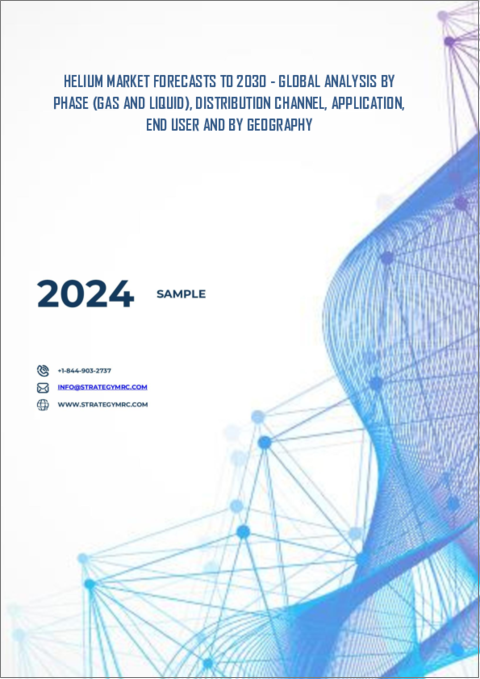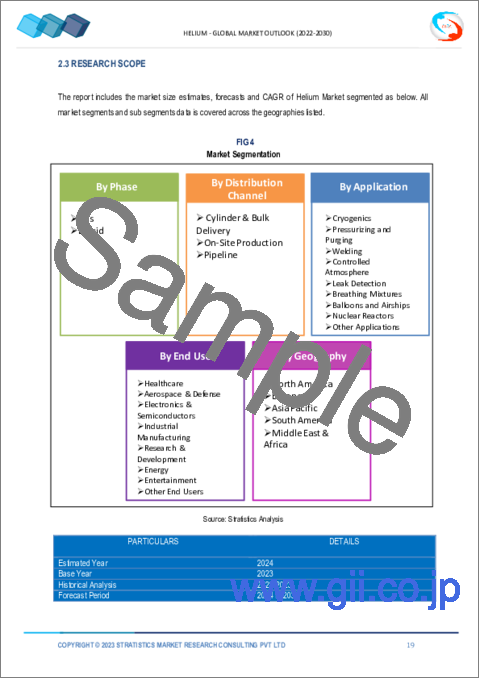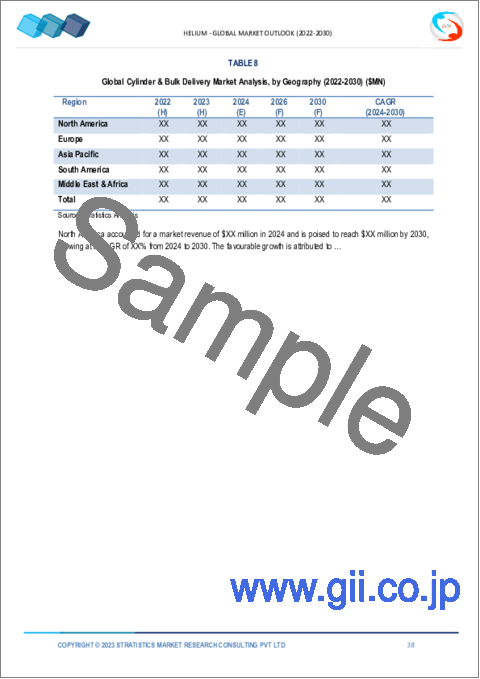|
|
市場調査レポート
商品コード
1494883
ヘリウム市場の2030年までの予測:相別、流通チャネル別、用途別、エンドユーザー別、地域別の世界分析Helium Market Forecasts to 2030 - Global Analysis By Phase (Gas and Liquid), Distribution Channel, Application, End User and By Geography |
||||||
カスタマイズ可能
|
|||||||
| ヘリウム市場の2030年までの予測:相別、流通チャネル別、用途別、エンドユーザー別、地域別の世界分析 |
|
出版日: 2024年06月06日
発行: Stratistics Market Research Consulting
ページ情報: 英文 200+ Pages
納期: 2~3営業日
|
全表示
- 概要
- 図表
- 目次
Stratistics MRCによると、世界のヘリウム市場は2024年に39億2,750万米ドルを占め、2030年には64億7,880万米ドルに達すると予測され、予測期間中のCAGRは8.7%です。
ヘリウムは周期表の第18族(希ガス)に属する不活性ガスです。最も軽い元素は水素だけで、ヘリウムは2番目に軽い元素です。ヘリウムは無色、無臭、無味で、-268.9℃(-452°F)という信じられないほど低い温度で液体になります。驚くべきことに、その沸点と凝固点は、既知のどの物質よりも低いです。ヘリウムは宇宙に豊富に存在し、その質量の約23%を占め、水素に次いで2番目に多いです。地球の大気中には少量(20万分の1)しか存在しないが、特に米国の天然ガス中にはかなりの量が含まれています。その軽さから、グッドイヤーブリンプのような飛行船に充填されるガスとして選ばれています。元素の中で最も沸点が低く、極低温で超流動や超伝導といった驚くべき性質を持つ液体になることができます。
国際磁気共鳴医学会によると、MRI検査を受けた患者は1億5,000万人を超えます。毎年、約1,000万人の患者がMRI検査を受けています。
ヘルスケア分野からの需要の高まり
ヘリウムは、MRI装置、極低温貯蔵、呼吸療法、医療機器のリーク検知など、さまざまな医療用途で使用される不可欠な元素です。慢性疾患の増加、医療画像技術の進歩、新興市場におけるヘルスケアインフラの拡大が、ヘルスケア分野におけるヘリウムの需要を牽引しています。冷却にヘリウムを利用するMRI装置は、特に先進国では画像診断用としてますます普及しています。
限られた埋蔵量と有限の資源
ヘリウムの限られた性質は、その市場に長い影を落としています。石油・天然ガスとは異なり、ヘリウムは地下に閉じ込められた再生不可能な資源です。一度抽出され放出されると、その軽さゆえに地球の大気圏を脱出してしまいます。そのため、供給量は刻一刻と減っていく。市場は2つの意味でこのピンチを感じています。資源が希少になるにつれて価格が上昇する可能性が高いです。第二に、MRIや宇宙探査のような重要な用途は、持続可能な代替品が開発されなければ、将来的に制限を受ける可能性があります。
拡大するエレクトロニクス産業
ヘリウムは、特に半導体と光ファイバーの分野で、さまざまな電子機器の製造と操作に重要な役割を果たしています。半導体製造では、ヘリウムはマイクロチップやその他の電子部品製造時の冷却とパージに不可欠です。この業界におけるヘリウムの需要は、スマートフォン、コンピューター、自動車用電子機器、IoT機器における高度な半導体技術の使用拡大が原動力となっています。さらに、ヘリウムは通信ネットワークの高速データ伝送用光ファイバーの製造にも使用されており、これが市場の成長を後押ししています。
高い抽出コスト
天然ガスからヘリウムを抽出するには、低温蒸留と精製という複雑な工程が必要で、これには特殊な設備と技術が必要となります。さらに、ヘリウムの抽出はしばしば遠隔地で行われるため、輸送・物流コストがさらに増大します。このような高い抽出コストが生産コスト全体の要因となり、ヘリウムは抽出・精製に最もコストのかかるガスのひとつとなっています。その結果、ヘリウム・サプライヤーは、様々な産業からの増大する需要を満たしながら収益性を維持しなければならないというプレッシャーに直面し、市場の成長を阻害しています。
COVID-19の影響
世界の景気減速により、製造業、ヘルスケア、エレクトロニクスなど様々な産業でヘリウムの需要が減少する一方、ヘルスケアセクターのヘリウム需要は、医療用途、特にMRI装置で不可欠な役割を担っているため、比較的安定していました。しかし、サプライチェーンの混乱や操業停止中の産業活動の低下がヘリウムの生産と流通に影響を及ぼし、供給と価格の短期的な変動につながった。
予測期間中、ガスセグメントが最大となる見込み
ヘリウムガスは、漏洩検知、ガスクロマトグラフィー、溶接・切断、冷却・冷凍、原子力など、様々な分野で採用が進んでいるため、予測期間中最大になると予想されます。さらに、ヘリウムガスは、物理学、化学、材料科学などの分野にまたがる科学研究と実験の領域で不可欠です。ヘリウムガスは、極低温研究、低温・高温調査において重要な役割を果たし、多数の分析機器においてキャリアーガスとしての役割を果たしています。
医療・ヘルスケア分野は予測期間中最も高いCAGRが見込まれる
医療・ヘルスケア分野は、MRI装置、内視鏡検査、レーザー技術、呼吸混合物、分光学、陽電子放射断層撮影(PET)など、医療・ヘルスケア分野のさまざまな分野で製品の利用が増加していることから、予測期間中に最も高いCAGRが見込まれます。ヘリウム充填気球、テザー気球、飛行船は、監視やモニタリングの目的で使用されます。レーダー、カメラ、通信機器など様々なペイロードに安定したプラットフォームを提供し、国境警備、軍事監視、災害管理などに使用されます。
最大のシェアを占める地域
北米は、ヘリウムを豊富に含む天然ガスの埋蔵量が豊富なため、予測期間中最大の市場シェアを占めると予測されています。さらに米国には、1925年に設立された世界最大級のヘリウム貯蔵施設である連邦ヘリウム備蓄があります。このヘリウム備蓄は、さまざまな産業にヘリウム製品を供給することで、世界市場で重要な役割を果たしてきました。それゆえ北米には、主に磁気共鳴画像装置(MRI)をはじめとする医療用画像診断機器にヘリウムを利用する、確立されたヘルスケア分野があります。
CAGRが最も高い地域:
欧州は、ヘルスケア、航空宇宙、エレクトロニクスなど様々なセクターからの高い需要により、予測期間中最も高いCAGRを維持すると予測されています。ドイツは、精密機器、画像診断、光学技術に重点を置き、高品質の医療機器を生産してきた長い歴史があります。米国、日本に次ぐ世界第3位の医療機器市場であり、欧州ではフランスの2倍、イタリア、英国、スペインの3倍の市場規模を誇る。
無料カスタマイズサービス:
本レポートをご購読のお客様には、以下の無料カスタマイズオプションのいずれかをご利用いただけます:
- 企業プロファイル
- 追加市場企業の包括的プロファイリング(3社まで)
- 主要企業のSWOT分析(3社まで)
- 地域セグメンテーション
- 顧客の関心に応じた主要国の市場推計・予測・CAGR(注:フィージビリティチェックによる)
- 競合ベンチマーキング
- 製品ポートフォリオ、地理的プレゼンス、戦略的提携に基づく主要企業のベンチマーキング
目次
第1章 エグゼクティブサマリー
第2章 序文
- 概要
- ステークホルダー
- 調査範囲
- 調査手法
- データマイニング
- データ分析
- データ検証
- 調査アプローチ
- 調査情報源
- 1次調査情報源
- 2次調査情報源
- 前提条件
第3章 市場動向分析
- 促進要因
- 抑制要因
- 機会
- 脅威
- 用途分析
- エンドユーザー分析
- 新興市場
- COVID-19の影響
第4章 ポーターのファイブフォース分析
- 供給企業の交渉力
- 買い手の交渉力
- 代替品の脅威
- 新規参入業者の脅威
- 競争企業間の敵対関係
第5章 世界のヘリウム市場:相別
- ガス
- 液体
第6章 世界のヘリウム市場:流通チャネル別
- シリンダーとバルク配送
- 現地生産
- パイプライン
第7章 世界のヘリウム市場:用途別
- 極低温工学
- 加圧とパージ
- 溶接
- 制御された雰囲気
- 漏れ検出
- 呼吸混合物
- 気球と飛行船
- 原子炉
- その他の用途
第8章 世界のヘリウム市場:エンドユーザー別
- ヘルスケア
- 航空宇宙および防衛
- エレクトロニクスおよび半導体
- 工業製造業
- 研究開発
- エネルギー
- エンターテインメント
- その他のエンドユーザー
第9章 世界のヘリウム市場:地域別
- 北米
- 米国
- カナダ
- メキシコ
- 欧州
- ドイツ
- 英国
- イタリア
- フランス
- スペイン
- その他欧州
- アジア太平洋
- 日本
- 中国
- インド
- オーストラリア
- ニュージーランド
- 韓国
- その他アジア太平洋
- 南米
- アルゼンチン
- ブラジル
- チリ
- その他南米
- 中東・アフリカ
- サウジアラビア
- アラブ首長国連邦
- カタール
- 南アフリカ
- その他中東・アフリカ
第10章 主な発展
- 契約、パートナーシップ、コラボレーション、合弁事業
- 買収と合併
- 新製品発売
- 事業拡大
- その他の主要戦略
第11章 企業プロファイリング
- Air Liquide
- Weil Group
- Air Products Inc.
- Exxon Mobil Corporation
- Gazprom PJSC
- Gulf Cryo S.A.L.
- IACX Energy
- Iwatani Corporation
- Linde Plc
- Matheson Tri-Gas Inc.
- MESA Specialty Gases & Equipment
- Messer Group
- NexAir LLC
- Pgnig Sa
- Qatarenergy Lng
- Renergen
- Taiyo Nippon Sanso India
List of Tables
- Table 1 Global Helium Market Outlook, By Region (2022-2030) ($MN)
- Table 2 Global Helium Market Outlook, By Phase (2022-2030) ($MN)
- Table 3 Global Helium Market Outlook, By Gas (2022-2030) ($MN)
- Table 4 Global Helium Market Outlook, By Liquid (2022-2030) ($MN)
- Table 5 Global Helium Market Outlook, By Distribution Channel (2022-2030) ($MN)
- Table 6 Global Helium Market Outlook, By Cylinder & Bulk Delivery (2022-2030) ($MN)
- Table 7 Global Helium Market Outlook, By On-Site Production (2022-2030) ($MN)
- Table 8 Global Helium Market Outlook, By Pipeline (2022-2030) ($MN)
- Table 9 Global Helium Market Outlook, By Application (2022-2030) ($MN)
- Table 10 Global Helium Market Outlook, By Cryogenics (2022-2030) ($MN)
- Table 11 Global Helium Market Outlook, By Pressurizing and Purging (2022-2030) ($MN)
- Table 12 Global Helium Market Outlook, By Welding (2022-2030) ($MN)
- Table 13 Global Helium Market Outlook, By Controlled Atmosphere (2022-2030) ($MN)
- Table 14 Global Helium Market Outlook, By Leak Detection (2022-2030) ($MN)
- Table 15 Global Helium Market Outlook, By Breathing Mixtures (2022-2030) ($MN)
- Table 16 Global Helium Market Outlook, By Balloons and Airships (2022-2030) ($MN)
- Table 17 Global Helium Market Outlook, By Nuclear Reactors (2022-2030) ($MN)
- Table 18 Global Helium Market Outlook, By Other Applications (2022-2030) ($MN)
- Table 19 Global Helium Market Outlook, By End User (2022-2030) ($MN)
- Table 20 Global Helium Market Outlook, By Healthcare (2022-2030) ($MN)
- Table 21 Global Helium Market Outlook, By Aerospace & Defense (2022-2030) ($MN)
- Table 22 Global Helium Market Outlook, By Electronics & Semiconductors (2022-2030) ($MN)
- Table 23 Global Helium Market Outlook, By Industrial Manufacturing (2022-2030) ($MN)
- Table 24 Global Helium Market Outlook, By Research & Development (2022-2030) ($MN)
- Table 25 Global Helium Market Outlook, By Energy (2022-2030) ($MN)
- Table 26 Global Helium Market Outlook, By Entertainment (2022-2030) ($MN)
- Table 27 Global Helium Market Outlook, By Other End Users (2022-2030) ($MN)
Note: Tables for North America, Europe, APAC, South America, and Middle East & Africa Regions are also represented in the same manner as above.
According to Stratistics MRC, the Global Helium Market is accounted for $3927.5 million in 2024 and is expected to reach $6478.8 million by 2030 growing at a CAGR of 8.7% during the forecast period. Helium is an inert gas found in Group 18 (noble gases) of the periodic table. It is the second lightest element, with only hydrogen being lighter. Helium is colorless, odorless, and tasteless, and it becomes a liquid at an incredibly low temperature of -268.9°C (-452°F). Remarkably, its boiling and freezing points are lower than those of any other known substance. Helium is abundant in the universe, constituting about 23% of its mass, second only to hydrogen. While it occurs in Earth's atmosphere in small amounts (1 part in 200,000), significant volumes are found in natural gases, especially in the United States. It's the gas of choice for filling airships like the Goodyear blimp due to its lightness. It has the lowest boiling point of all elements, and it can become a liquid with remarkable properties, such as superfluidity and superconductivity at extremely low temperatures.
According to the International Society for Magnetic Resonance in Medicine, over 150 million patients underwent MRI examinations. Every year, approximately 10 million patients undergo MRI procedures.
Market Dynamics:
Driver:
Growing demand from healthcare sector
Helium is an essential element used in various medical applications, including MRI machines, cryogenic storage, respiratory therapy, and leak detection in medical devices. The increasing prevalence of chronic diseases, advancements in medical imaging technologies and the expanding healthcare infrastructure in emerging markets are driving the demand for helium in the healthcare sector. MRI machines, which rely on helium for cooling, are becoming increasingly widespread for diagnostic imaging, particularly in developed countries.
Restraint:
Limited reserves & finite resources
Helium's limited nature casts a long shadow on its market. Unlike oil or natural gas, it's a non-renewable resource trapped underground. Once extracted and released, it escapes Earth's atmosphere due to its lightness. This creates a ticking clock on the supply. The market feels this pinch in two ways. Prices are likely to rise as the resource becomes more scarce. Secondly, crucial applications like MRIs and space exploration face potential future limitations if sustainable alternatives aren't developed.
Opportunity:
Expanding electronics industry
Helium plays a crucial role in the production and operation of various electronic devices, particularly in the semiconductor and fiber optics sectors. In semiconductor manufacturing, helium is essential for cooling and purging during the production of microchips and other electronic components. The demand for helium in this industry is driven by the growing use of advanced semiconductor technologies in smartphones, computers, automotive electronics, and IoT devices. Additionally, helium is used in the production of optical fibers for high-speed data transmission in telecommunications networks which drives the markets growth.
Threat:
High extraction costs
Extracting helium from natural gas involves a complex process of cryogenic distillation and purification, which requires specialized equipment and technology. Additionally, helium extraction often occurs in remote locations, further increasing transportation and logistical costs. These high extraction costs contribute to the overall production expenses, making helium one of the most expensive gases to extract and purify. As a result, helium suppliers face pressure to maintain profitability while meeting the growing demand from various industries impedes the market growth.
Covid-19 Impact
While the global economic slowdown led to reduced demand for helium across various industries such as manufacturing, healthcare, and electronics, the healthcare sector's demand for helium remained relatively stable due to its essential role in medical applications, particularly in MRI machines. However, supply chain disruptions and decreased industrial activity during lockdowns affected helium production and distribution, leading to short-term fluctuations in supply and prices.
The gas segment is expected to be the largest during the forecast period
The gas is expected to be the largest during the forecast period attributed to increasing product adoption in various areas of applications including leak detection, gas chromatography, welding & cutting, cooling & refrigeration, and in nuclear power, among others. Furthermore, helium gas is indispensable in the realm of scientific research and experimentation, spanning disciplines, such as physics, chemistry, and materials science. It plays a critical role in cryogenic studies, low-& temperature investigations, and serves as a carrier gas in a multitude of analytical instruments.
The medical & healthcare segment is expected to have the highest CAGR during the forecast period
The medical & healthcare segment is expected to have the highest CAGR during the forecast period owing to the increasing product usage in various areas of applications in the medical & healthcare sectors, such as MRI machines, endoscopy, laser technology, breathing mixtures, spectroscopy, and in positron emission tomography (PET), among others. Helium-filled aerostats, tethered balloons, or blimps are used for surveillance and monitoring purposes. They provide a stable platform for various payloads, including radar, cameras, and communication equipment, which are used in border security, military surveillance, and disaster management.
Region with largest share:
North America is projected to hold the largest market share during the forecast period due to the presence of abundant reserves of helium-rich natural gas. In addition, the U.S. is home to the Federal Helium Reserve, which was established in 1925 and is one of the world's largest helium storage facilities. The reserve has played a significant role in the global market by supplying the product to various industries. Hence North America has a well-established healthcare sector that relies on helium for medical imaging equipment, primarily magnetic resonance imaging (MRI) machines.
Region with highest CAGR:
Europe is projected to hold the highest CAGR over the forecast period owing to the high demand from different sectors, such as healthcare, aerospace, electronics, and others. Germany has a long history of producing high-quality medical equipment, emphasizing precision instruments, diagnostic imaging, and optical technologies. The nation hosts the third-largest medical devices market in the world, after the United States and Japan, and the largest in Europe, comprising twice the size of the French market and three times as large as those of Italy, the United Kingdom, and Spain.
Key players in the market
Some of the key players in Helium market include Air Liquide, Weil Group, Air Products Inc., Exxon Mobil Corporation, Gazprom PJSC, Gulf Cryo S.A.L., IACX Energy, Iwatani Corporation, Linde Plc, Matheson Tri-Gas Inc., MESA Specialty Gases & Equipment, Messer Group, NexAir LLC, Pgnig Sa, Qatarenergy Lng, Renergen, Taiyo Nippon Sanso India.
Key Developments:
In May 2024, Air Liquide takes a step further in sustainable biomethane production with a charter built in collaboration with WWF France. The Group is committed to measure and track progress towards more sustainable production, while contributing to the development of a worldwide production framework.
In May 2024, ExxonMobil completes acquisition of Pioneer Natural Resources. The merger of ExxonMobil and Pioneer creates an Unconventional business with the largest, high-return development potential in the Permian Basin.
In April 2024, Air Liquide strengthens its Home Healthcare activity with an acquisition in Belgium and the Netherlands. The two entities acquired in Belgium and the Netherlands support 10,000 patients living with respiratory insufficiency, sleep apnea syndrome or requiring infusion or nutrition treatments.
Phases Covered:
- Gas
- Liquid
Distribution Channels Covered:
- Cylinder & Bulk Delivery
- On-Site Production
- Pipeline
Applications Covered:
- Cryogenics
- Pressurizing and Purging
- Welding
- Controlled Atmosphere
- Leak Detection
- Breathing Mixtures
- Balloons and Airships
- Nuclear Reactors
- Other Applications
End Users Covered:
- Healthcare
- Aerospace & Defense
- Electronics & Semiconductors
- Industrial Manufacturing
- Research & Development
- Energy
- Entertainment
- Other End Users
Regions Covered:
- North America
- US
- Canada
- Mexico
- Europe
- Germany
- UK
- Italy
- France
- Spain
- Rest of Europe
- Asia Pacific
- Japan
- China
- India
- Australia
- New Zealand
- South Korea
- Rest of Asia Pacific
- South America
- Argentina
- Brazil
- Chile
- Rest of South America
- Middle East & Africa
- Saudi Arabia
- UAE
- Qatar
- South Africa
- Rest of Middle East & Africa
What our report offers:
- Market share assessments for the regional and country-level segments
- Strategic recommendations for the new entrants
- Covers Market data for the years 2022, 2023, 2024, 2026, and 2030
- Market Trends (Drivers, Constraints, Opportunities, Threats, Challenges, Investment Opportunities, and recommendations)
- Strategic recommendations in key business segments based on the market estimations
- Competitive landscaping mapping the key common trends
- Company profiling with detailed strategies, financials, and recent developments
- Supply chain trends mapping the latest technological advancements
Free Customization Offerings:
All the customers of this report will be entitled to receive one of the following free customization options:
- Company Profiling
- Comprehensive profiling of additional market players (up to 3)
- SWOT Analysis of key players (up to 3)
- Regional Segmentation
- Market estimations, Forecasts and CAGR of any prominent country as per the client's interest (Note: Depends on feasibility check)
- Competitive Benchmarking
- Benchmarking of key players based on product portfolio, geographical presence, and strategic alliances
Table of Contents
1 Executive Summary
2 Preface
- 2.1 Abstract
- 2.2 Stake Holders
- 2.3 Research Scope
- 2.4 Research Methodology
- 2.4.1 Data Mining
- 2.4.2 Data Analysis
- 2.4.3 Data Validation
- 2.4.4 Research Approach
- 2.5 Research Sources
- 2.5.1 Primary Research Sources
- 2.5.2 Secondary Research Sources
- 2.5.3 Assumptions
3 Market Trend Analysis
- 3.1 Introduction
- 3.2 Drivers
- 3.3 Restraints
- 3.4 Opportunities
- 3.5 Threats
- 3.6 Application Analysis
- 3.7 End User Analysis
- 3.8 Emerging Markets
- 3.9 Impact of Covid-19
4 Porters Five Force Analysis
- 4.1 Bargaining power of suppliers
- 4.2 Bargaining power of buyers
- 4.3 Threat of substitutes
- 4.4 Threat of new entrants
- 4.5 Competitive rivalry
5 Global Helium Market, By Phase
- 5.1 Introduction
- 5.2 Gas
- 5.3 Liquid
6 Global Helium Market, By Distribution Channel
- 6.1 Introduction
- 6.2 Cylinder & Bulk Delivery
- 6.3 On-Site Production
- 6.4 Pipeline
7 Global Helium Market, By Application
- 7.1 Introduction
- 7.2 Cryogenics
- 7.3 Pressurizing and Purging
- 7.4 Welding
- 7.5 Controlled Atmosphere
- 7.6 Leak Detection
- 7.7 Breathing Mixtures
- 7.8 Balloons and Airships
- 7.9 Nuclear Reactors
- 7.10 Other Applications
8 Global Helium Market, By End User
- 8.1 Introduction
- 8.2 Healthcare
- 8.3 Aerospace & Defense
- 8.4 Electronics & Semiconductors
- 8.5 Industrial Manufacturing
- 8.6 Research & Development
- 8.7 Energy
- 8.8 Entertainment
- 8.9 Other End Users
9 Global Helium Market, By Geography
- 9.1 Introduction
- 9.2 North America
- 9.2.1 US
- 9.2.2 Canada
- 9.2.3 Mexico
- 9.3 Europe
- 9.3.1 Germany
- 9.3.2 UK
- 9.3.3 Italy
- 9.3.4 France
- 9.3.5 Spain
- 9.3.6 Rest of Europe
- 9.4 Asia Pacific
- 9.4.1 Japan
- 9.4.2 China
- 9.4.3 India
- 9.4.4 Australia
- 9.4.5 New Zealand
- 9.4.6 South Korea
- 9.4.7 Rest of Asia Pacific
- 9.5 South America
- 9.5.1 Argentina
- 9.5.2 Brazil
- 9.5.3 Chile
- 9.5.4 Rest of South America
- 9.6 Middle East & Africa
- 9.6.1 Saudi Arabia
- 9.6.2 UAE
- 9.6.3 Qatar
- 9.6.4 South Africa
- 9.6.5 Rest of Middle East & Africa
10 Key Developments
- 10.1 Agreements, Partnerships, Collaborations and Joint Ventures
- 10.2 Acquisitions & Mergers
- 10.3 New Product Launch
- 10.4 Expansions
- 10.5 Other Key Strategies
11 Company Profiling
- 11.1 Air Liquide
- 11.2 Weil Group
- 11.3 Air Products Inc.
- 11.4 Exxon Mobil Corporation
- 11.5 Gazprom PJSC
- 11.6 Gulf Cryo S.A.L.
- 11.7 IACX Energy
- 11.8 Iwatani Corporation
- 11.9 Linde Plc
- 11.10 Matheson Tri-Gas Inc.
- 11.11 MESA Specialty Gases & Equipment
- 11.12 Messer Group
- 11.13 NexAir LLC
- 11.14 Pgnig Sa
- 11.15 Qatarenergy Lng
- 11.16 Renergen
- 11.17 Taiyo Nippon Sanso India





